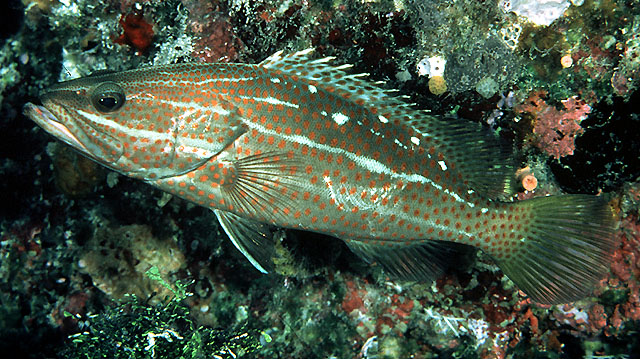| Epinephelidae (Groupers) |
| 65 cm TL (male/unsexed) |
|
reef-associated; marine; depth range 0 - 80 m, non-migratory |
| Indo-Pacific: Red Sea south to Mozambique and east to the Phoenix Islands, north to Japan, south to Australia. Probably including all the islands of the tropical Indian Ocean. |
|
Dorsal spines (total): 11-11; Dorsal soft rays (total): 14-16; Anal spines: 3-3; Anal soft rays: 8-9. This species is distinguished by the following characters: body and head elongate and markedly compressed, its depth distinctly less than head length, 3.1-3.7 times in standard length; body width 2.3-2.8 times in body depth; no palatine teeth; caudal fin rounded. Colour of adults greenish to brownish grey with numerous orange-red spots on head (becoming smaller anteriorly), body, dorsal fin, and basally on caudal fin;3-4 longitudinal whitish bands or series of streaks often visible on postorbital head and body; membranes of soft dorsal, anal, and caudal fins clear; juveniles with longitudinal pale bluish grey stripes on a gold or yellow background; a blue-edged black spot (or double spot) at base of caudal fin and another at base of soft dorsal fin (Ref. 5222, 39231, 90102). |
| Solitary adults inhabit coral rich areas and clear waters on lagoon and seaward reefs (Ref 90102). They feed mainly on fishes and probably on crustaceans. The distinctive blue and gold striped juveniles are mimics of the wrasse Halichoeres purpurescens (Ref. 39231) or dark damsels in surge zones (Ref. 48635). This allows the species to approach their preys. Often seen in markets but not plentiful enough to be of commercial importance. Caught with hook-and-line, spear, and probably in traps (Ref. 39231). Sold in Hong Kong live fish markets (Ref. 27253). Minimum depth reported taken from Ref. 128797. |
|
Least Concern (LC); Date assessed: 22 November 2016 Ref. (130435)
|
| harmless |
Source and more info: www.fishbase.org. For personal, classroom, and other internal use only. Not for publication.

